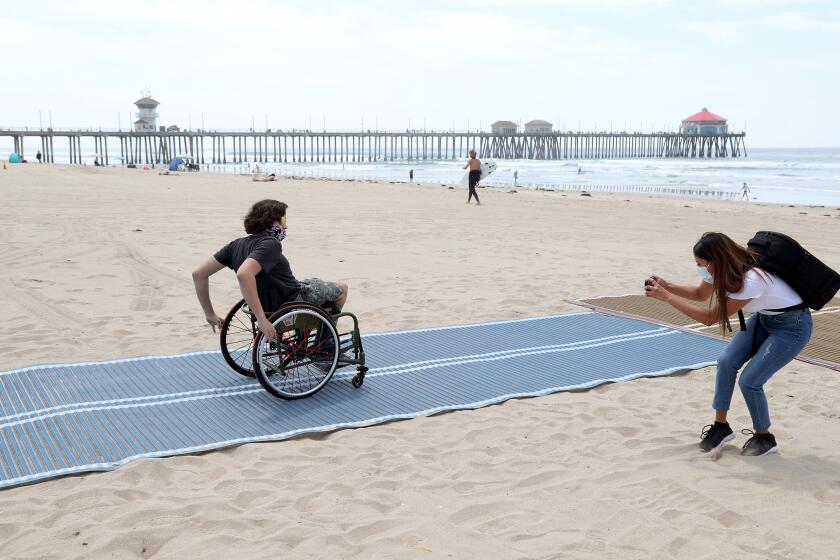OCMA to put on Jack Goldstein show
- Share via
The Orange County Museum of Art on Sunday will open the first U.S. retrospective exhibition of works by the Canadian-born mixed-media artist Jack Goldstein (1945-2003), who was a central figure of the 1970s and 80s Postmodern Art movement and Pictures Generation.
OCMA’s “Jack Goldstein X 10,000” exhibit will be a museum-wide show featuring more than 75 pieces, including a selection of 22 paintings, 20 films, 18 sound recordings and two large-scale installations, which the late Goldstein created during his influential yet enigmatic career.
The show concludes with never-before-shown writings by the artist, namely aphorisms and short texts that he produced between 1982 and 2002, supplemented by a photo-essay from his colleague James Welling.
‘It’s very surprising to me that this will be the first American retrospective [of Goldstein’s work],” Philipp Kaiser, guest curator of the exhibit, said in an interview. “He’s a household name and mythical figure among Postmodern artists and art students. His work has been shown all over the world since the 80s, but not in the U.S., which is odd considering his roots as a California artist.”
Goldstein spent most of his life in Southern California. He studied at the Chouinard Art Institute and then the California Institute of the Arts, where he was the first person to receive a Cal Arts master of fine arts degree in 1972.
Goldstein spent time in New York in the 1980s, where he made a lasting impact, according to a biography of Goldstein on his estate’s website. He returned to California in the ‘90s and disappeared from the art scene until he made a brief comeback in the early 2000s, soon before his death
Kaiser, 39, is from Switzerland. In November, he will become the new director of Museum Ludwig in Cologne, Germany. He began to develop “Jack Goldstein x 10,000” for the Museum of Contemporary Art in Los Angeles in 2010, but it was dropped from the program. OCMA reinstated the exhibition and brought him with it.
Having been immersed in Goldstein’s life and work for several years, Kaiser cites the artist’s heroin addiction and suicide as contributors to his ephemeral art and legacy.
“He’s such a paradigmatic artist,” Kaiser said. “With his work and in his life, he tried to disappear on so many levels. He was very much about leaving no traces. He didn’t hold the camera when he made the films. He didn’t paint the paintings; he didn’t even touch his canvas. He would hire someone to produce his films and had assistants paint his visions. It’s fascinating how deep he took this concept of appropriating art.”
Kaiser noted that he based his title for the exhibit on the following direct quote from an interview Goldstein had with Chris Dercon on a Belgian television show in 1985:
“You wake up in the morning and look at yourself in the mirror and go, ‘Who is that?’ and ‘What is that?’ and ‘What do you call it?’ and ‘What’s my name?’” Goldstein told the show’s host. “My name,” he concluded, “it’s the name of a name. It’s not my name … Imagine, if you look in the telephone book, there must be ten thousand Jack Goldsteins.”
Expanding on that message, Kaiser said, “The exhibit title and the quote mean, on one hand, that he’s huge and all over the place, but at the same time, he is also mirrored and nowhere. He’s forever present and forever vanishing. It’s very cryptic but appropriate. It’s what has had generations of Postmodern artists worshiping him.”
Kaiser was particularly excited by one piece in the exhibit, the “Burning Window” installation, which Goldstein created in 1977. The installation is an illuminated, red-textured Plexiglas panel window installed on a red wall in an enclosed empty room. Lights flicker behind the pane.
“It’s comes across like cinematic special effects with fire,” Kaiser said, “functioning as a safe way to look at the world outside aflame, a stylized inferno. Goldstein was obsessed with spectacles — fire, lightning, explosions — and it’s so clear in this piece.”
Kaiser also emphasized the importance of Goldstein’s selected writings, stating that toward the end of his troubled life, Goldstein spent hours in Los Angeles libraries reading the works of great philosophers, peeling pieces from their theories and recording them backward in short, collaged excerpts.
If You Go
What: “Jack Goldstein X 10,000”
Where: Orange County Museum of Art, 850 San Clemente Drive, Newport Beach
When: June 24 through Sept. 9
Hours: OCMA is open from 11 a.m. to 5 p.m. on Wednesdays, Fridays, Saturdays and Sundays, and from 11 a.m. to 8 p.m. on Thursdays. The museum is closed on Mondays and Tuesdays.
More Information: For ticket prices and policies, visit https://www.ocma.net and click on “hours and admission” under the “visit” tab.
All the latest on Orange County from Orange County.
Get our free TimesOC newsletter.
You may occasionally receive promotional content from the Daily Pilot.





